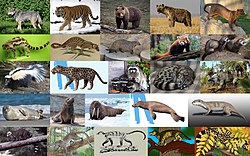
Summary
Los carnivoramorfos (Carnivoramorpha, gr. "con forma de carnívoro") son un clado de mamíferos que incluye al moderno orden Carnivora y a sus más cercanos parientes extintos del orden Miacoidea (las familias Miacinae y Viverravidae), pero excluye a los creodontos. El orden Creodonta es el taxón hermano de Carnivoramorpha datando de hace 58,7 millones de años. Los más antiguos carnivoramorfos son los viverrávidos, y el más antiguo viverrávido generalmente aceptado es Protictis de hace unos 63 millones de años. Ravenictis, de Canadá, puede ser también un carnivoramorfo y esto podría extender el linaje hasta hace unos 65 millones de años en el pasado.[1]
| Carnivoramorpha | ||
|---|---|---|
| Rango temporal: Paleoceno - Presente 66,043 Ma - 0 Ma | ||
 | ||
| Taxonomía | ||
| Reino: | Animalia | |
| Filo: | Chordata | |
| Clase: | Mammalia | |
| (sin rango): |
Carnivoramorpha Wyss & Flynn, 1993 | |
| subgrupos | ||
Clasificación y filogenia
editar- Clado Carnivoramorpha (basales a Carnivora pero no incluyen a los creodontes)
- Superfamilia †Miacoidea
- Familia †Miacidae
- Subfamilia †Miacinae
- Géneros: Chailicyon, Eostictis, Ictognathus, Miacis, Miocyon, Oodectes, Palaearctonyx, Paramiacis, Paroodectes, Prodaphaemus, Quercgyale, Tapocyon, Uintacyon, Vassacyon, Vulpavus, Xinyuictis, Ziphacodon
- Subfamilia †Viverravidae
- Géneros: Bryanictis, Didymictis, Ictidopappus, Pristinictis, Protictis, Raphictis, Simpsonictis, Viverravus
- Subfamilia †Miacinae
- Familia †Miacidae
- Orden Carnivora
- Superfamilia Caniformia o Canoidea
- Superfamilia Feliformia o Feloidea
- Superfamilia †Miacoidea
Filogenia
editarLas relaciones filogenéticas de Carnivoramorpha son mostradas en el siguiente cladograma:[2][3][4][5][6][7][8][9]
| Ferae |
| |||||||||||||||||||||||||||||||||||||||||||||||||||||||||||||||||||||||||||||||||||||||||||||||||||||||||||||||||||||||||||||||||||||||||||||||||||||||||||||||||||||||||||||||||||||||||||||||||||||||
Referencias
editar- ↑ Bryant, H.N., and M. Wolson (2004) “Phylogenetic Nomenclature of Carnivoran Mammals.” First International Phylogenetic Nomenclature Meeting. Paris, Museum National d’Histoire Naturelle, July 6-9, 2004. «Copia archivada». Archivado desde el original el 6 de julio de 2008. Consultado el 20 de noviembre de 2013.
- ↑ Bryant, H.N., and M. Wolson (2004) “Phylogenetic Nomenclature of Carnivoran Mammals.” First International Phylogenetic Nomenclature Meeting. Paris, Museum National d’Histoire Naturelle
- ↑ John J. Flynn; John A. Finarelli; Michelle Spaulding (2010). «Phylogeny of the Carnivora and Carnivoramorpha, and the use of the fossil record to enhance understanding of evolutionary transformations». En Anjali Goswami; Anthony Friscia, eds. Carnivoran evolution. New views on phylogeny, form and function. Cambridge University Press. pp. 25–63. ISBN 9781139193436. doi:10.1017/CBO9781139193436.003.
- ↑ Michelle Spaulding; John J. Flynn; Richard K. Stucky (2010). «A new basal Carnivoramorphan (Mammalia) from the 'Bridger B' (Black's Fork member, Bridger Formation, Bridgerian Nalma, middle Eocene) of Wyoming, USA». Palaeontology 53 (4): 815-832. doi:10.1111/j.1475-4983.2010.00963.x.
- ↑ Susumu Tomiya (2011). «A new basal caniform (Mammalia: Carnivora) from the Middle Eocene of North America and remarks on the phylogeny of early carnivorans». PLOS One 6 (9): e24146. PMC 3173397. PMID 21935380. doi:10.1371/journal.pone.0024146.
- ↑ Solé, Floréal; Smith, Richard; Coillot, Tiphaine; de Bast, Eric; Smith, Thierry (2014). «Dental and tarsal anatomy of Miacis latouri and a phylogenetic analysis of the earliest carnivoraforms (Mammalia, Carnivoramorpha)». Journal of Vertebrate Paleontology 34 (1): 1-21. ISSN 0272-4634. doi:10.1080/02724634.2013.793195.
- ↑ Solé, Floréal; Smith, Thierry; De Bast, Eric; Codrea, Vlad; Gheerbrant, Emmanuel (2016). «New carnivoraforms from the latest Paleocene of Europe and their bearing on the origin and radiation of Carnivoraformes (Carnivoramorpha, Mammalia)». Journal of Vertebrate Paleontology 36 (2): e1082480. ISSN 0272-4634. doi:10.1080/02724634.2016.1082480.
- ↑ Solé, F. & Ladevèze, S. (2017). "Evolution of the hypercarnivorous dentition in mammals (Metatheria, Eutheria) and its bearing on the development of tribosphenic molars." Evolution & Development, 19(2), 56–68.
- ↑ Prevosti, F. J., & Forasiepi, A. M. (2018). "Introduction. Evolution of South American Mammalian Predators During the Cenozoic: Paleobiogeographic and Paleoenvironmental Contingencies"
- Archibold, J.D., and K.D. Rose (eds.). (2005). “The Rise of Placental Mammals: Origins and Relationships of the Major Clades.” Baltimore and London: The Johns Hopkins University Press. ISBN 0-8018-8022-X
- Archibold, J.D., and K.D. Rose. (2005). “Womb with a View: the Rise of Placentals.” [1]
- Benton, Michael J. and Philip C.J. Donoghue. (2007). “Paleontological Evidence to Date the Tree of Life.” Dating the Tree of Life 31. [2]
- Flynn, John J. and Gina D. Wesley-Hunt. 2005. "Phylogeny of the Carnivora: Basal Relationships Among the Carnivoramorphans, and Assessment of the Position of 'Miacoidea' Relative to Carnivora." Journal of Systematic Paleontology, 3: 1-28. Abstract: [3]
- Haaramo, Mikko. (2005). “Mikko's Phylogeny Archive Carnivoramorpha - Carnivores and relatives.” Retrieved February 17, 2007, from: [4] Archivado el 19 de mayo de 2001 en Wayback Machine.
- Stiles, David P. (2005). “An investigation of the Vulpes and Urocyon phylogenetic classification: Feliformia or Caniformia?” Fox Phylogeny. Vertebrate Evolution – Fall 2005, The Evergreen State College, Olympia, WA. [5]
- Wesley-Hunt, Gina D. (2006). “The Morphological Diversification of Carnivores in North America.” Paleobiology. Vol. 31, Issue 1, pp. 35–55. [6]
- Wyss, A. R. & Flynn, J. J. (1993). “A Phylogenetic Analysis and Definition of the Carnivora.” in Mammal Phylogeny – Placentals, Szalay, F.S., M.J. Novacek and M.C. McKenna (eds.). ISBN 0387978534.


